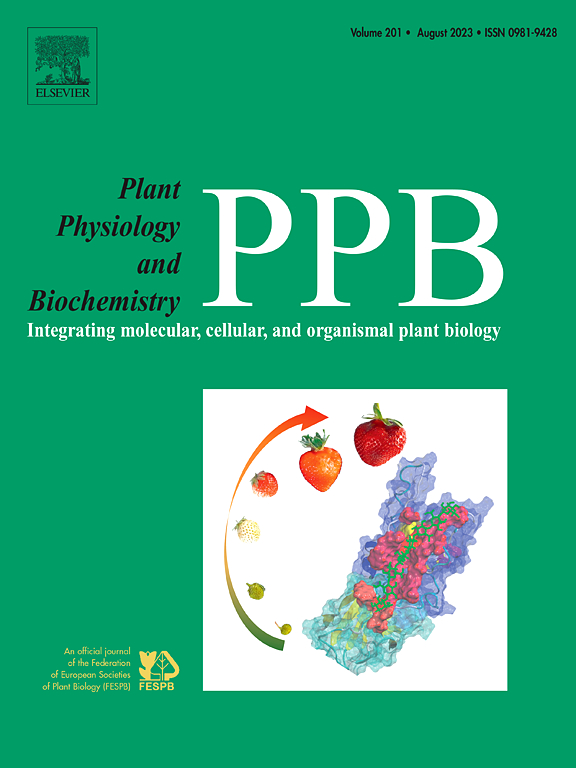杏(Hacihaliloğlu)与Prunus cerasifera Ehrh的早期形态、生化和解剖相容性。根茎候选人
IF 5.7
2区 生物学
Q1 PLANT SCIENCES
引用次数: 0
摘要
引进新的砧木需要了解相容性反应,以评估弱结合的风险,在市场发布之前为苗圃和果农提供必要的信息。因此,本研究评估了Hacıhaliloğlu杏与13个李子砧木候选材料和Myrobalan 29C(对照)的嫁接相容性,通过各种生长、生理、解剖和生化参数来研究相容性。结果表明,Myrobalan 29C (MYRO29C)植株最高,砧木直径最大,树干横截面积(TCSA)最高,而63B61植株最短,TCSA最低。其中63B69的叶面积最大,63B43和63B72的叶面积最小。嫁接成功率各不相同,H/63B11嫁接成功率最高,H/63B72嫁接成功率最低。形态学分析表明,H/MYRO29C的嫁接植株最高,H/63B76的嫁接植株最短。尽管存在这些差异,但所有的移植物组合都显示出成功的组织整合,被归类为“高度相容”或“相容”。H/63B11和H/63B14组合叶绿素含量增加,其他组合总体下降。MYRO29C和H/MYRO29C表现出最高的归一化植被差异ındex (NDVI)和气孔导度。生化分析显示,淀粉、蔗糖、葡萄糖和果糖含量存在显著差异,其中H/63B33的过氧化物酶活性最高。聚类分析表明,MYRO29C、63B11、63B14、63B33、63H66和63H69是最有希望的候选砧木。本研究结果表明,63B11、63B14、63B33、63H66和63H69是最有前途的砧木候选品种,有可能作为Myrobalan29C的替代品,促进杏的生长和生理反应,为提高杏的产量提供有价值的信息。本文章由计算机程序翻译,如有差异,请以英文原文为准。
Early stage morphological, biochemical, and anatomical compatibility of apricot (Hacihaliloğlu) with Prunus cerasifera Ehrh. Rootstock candidates
The introducing new rootstocks requires understanding compatibility reactions to assess the risk of weak unions, providing nursery and fruit growers with essential information before market release. Therefore, this study evaluated the graft compatibility of Hacıhaliloğlu apricot with thirteen plum rootstock candidates and Myrobalan 29C (control), investigating compatibility through various growth, physiological, anatomical, and biochemical parameters. Based on the results, Myrobalan 29C (MYRO29C) developed the tallest plants, with the largest rootstock diameter and highest trunk cross-sectional area (TCSA), while 63B61 remained the shortest and recorded the lowest values. Among the rootstocks, 63B69 had the largest leaf area, while 63B43 and 63B72 showed the smallest. Grafting success varied, with H/63B11 achieving the highest success rate, and H/63B72 the lowest. Morphological assessments indicated that H/MYRO29C produced the tallest grafted plants, while H/63B76 resulted in the shortest. Despite these differences, all graft combinations showed successful tissue integration, categorized as “highly compatible” or “compatible.” Chlorophyll content increased in H/63B11 and H/63B14, while other combinations exhibited a general decline. MYRO29C and H/MYRO29C showed the highest normalized difference vegetation ındex (NDVI) and stomatal conductance. Biochemical analysis revealed significant differences in starch, sucrose, glucose, and fructose content, with H/63B33 exhibiting the highest peroxidase activity. Cluster analysis identified MYRO29C, 63B11, 63B14, 63B33, 63H66 and 63H69 as the most promising rootstock candidates. The results of this study highlight 63B11, 63B14, 63B33, 63H66 and 63H69 as the most promising rootstock candidates, with the potential to serve as alternatives to Myrobalan29C for enhancing apricot growth and physiological responses, providing valuable insights for improving apricot production.
求助全文
通过发布文献求助,成功后即可免费获取论文全文。
去求助
来源期刊
CiteScore
11.10
自引率
3.10%
发文量
410
审稿时长
33 days
期刊介绍:
Plant Physiology and Biochemistry publishes original theoretical, experimental and technical contributions in the various fields of plant physiology (biochemistry, physiology, structure, genetics, plant-microbe interactions, etc.) at diverse levels of integration (molecular, subcellular, cellular, organ, whole plant, environmental). Opinions expressed in the journal are the sole responsibility of the authors and publication does not imply the editors'' agreement.
Manuscripts describing molecular-genetic and/or gene expression data that are not integrated with biochemical analysis and/or actual measurements of plant physiological processes are not suitable for PPB. Also "Omics" studies (transcriptomics, proteomics, metabolomics, etc.) reporting descriptive analysis without an element of functional validation assays, will not be considered. Similarly, applied agronomic or phytochemical studies that generate no new, fundamental insights in plant physiological and/or biochemical processes are not suitable for publication in PPB.
Plant Physiology and Biochemistry publishes several types of articles: Reviews, Papers and Short Papers. Articles for Reviews are either invited by the editor or proposed by the authors for the editor''s prior agreement. Reviews should not exceed 40 typewritten pages and Short Papers no more than approximately 8 typewritten pages. The fundamental character of Plant Physiology and Biochemistry remains that of a journal for original results.

 求助内容:
求助内容: 应助结果提醒方式:
应助结果提醒方式:


